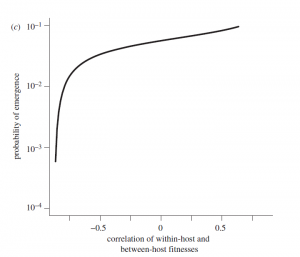Multiple scales of selection influence the evolutionary emergence of novel pathogens
The ability of a pathogen to adapt to a new environment – whether this be a different host species or an antimicrobial drug – is the primary factor that determines its ability to invade and persist. This adaptation to new environments can occur at both the within-host level and the between-host level, but most studies consider pathogen fitness at only one of these scales. To address this problem, Park et al. (2013) create a model to examine how interactions between selection at the within-host and between-host scales drive the probability of novel pathogen emergence. In their model, they consider a range of scenarios in the rate and relative strength of changes in fitness at these two scales, then calculate the probability of emergence given each of these scenarios. They find that interactions between the scales are important drivers of the probability of emergence; for instance, when within-host gains in fitness are initially fast but then slow down, the probability of emergence is more closely tied to between-host fitness (i.e. R0) than when within-host fitness gains proceed at an equal rate or increase in speed. In addition, unsurprisingly, the authors find that the probability of disease emergence is highest when there are strong positive correlations between within-host and between-host fitness, but the shape of this relationship shows is somewhat unexpected, where the probability of emergence remains relatively high until the correlation between within- and between-host fitness drops below about -0.6 (see Figure 4 below). Overall, the authors emphasize that the rate and order of mutations can drive substantial differences in the probability of emergence, pointing to the importance of considering both within- and between-host experiments when trying to evaluate the likelihood of emergence of a novel pathogen.

Figure 4 from Park et al. (2013)
Park, M., Loverdo, C., Schreiber, S. J., & Lloyd-Smith, J. O. (2013). Multiple scales of selection influence the evolutionary emergence of novel pathogens. Philosophical Transactions of the Royal Society of London B: Biological Sciences, 368(1614), 20120333.
